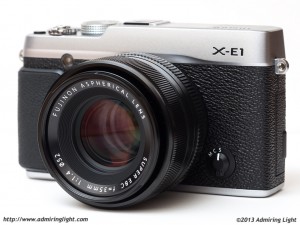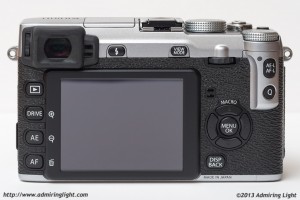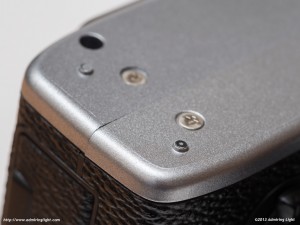
Fuji is a relative newcomer to the mirrorless game, and they’ve taken a different strategy than the other players in this market. Fuji has eschewed the entire low-end market and decided to focus on prosumer and professional users exclusively.
Last year, they introduced the X-Pro 1, a relatively large body with a hybrid optical and electronic viewfinder, along with three solid prime lenses. A few months later, the Fujifilm X-E1 was announced, featuring the exact same 16 megapixel X-Trans sensor in a smaller package with a better electronic viewfinder, at the expense of the optical finder.
So, let’s take a look at how this rangefinder style mirrorless body stacks up with the growing competition in this market segment.
Note: this review was originally written after reviewing the camera with Firmware 1.05. Updates have been made when newer firmware versions have added features or improved camera operation. These notes will be in italics following the original text of the review. Substantial portions of the conclusion were revised after release of firmware v. 2.0.
If you’re not familiar with my reviews, I review from a real world shooting perspective. You won’t find lens charts or resolution numbers here. There are plenty of other sites that cover those. I review products on how they act for me as a photographic tool. I am not a videographer, so my reviews concentrate on the still imaging capabilities of a camera.
Body and Ergonomics

The Fujifilm X-E1 follows the rest of Fuji’s recent offerings with a distinctly retro style. The camera looks an awful lot like a classic rangefinder, minus the rangefinder window and optical viewfinder. It comes in silver or black and the main body is wrapped in a black leatherette, recalling SLRs and rangefinders of the 1960s and 1970s.
The main body is made of a thin-walled metal, and while the leatherette itself isn’t very grippy, Fuji has included an extra rubber grip on the front edge that makes the grip on the camera secure. The camera looks quite boxy and appears larger than it really is, even when you’re holding it. It’s very similar in size to the Olympus OM-D, being just a little wider, but also shorter due to the lack of a viewfinder hump. I find the camera rather comfortable to hold for the most part, and controls are very easily accessible. The only odd ergonomic item is the positioning of the AF button, which is a little awkwardly placed at the left edge. I’d have preferred a top plate or thumb accessible button for this, so that it was easier to change the focus point while the viewfinder is up to your eye.
Update: With firmware v.1.06, Fuji has added the ability for the down arrow on the four-way controller to act as a programmable function button. By default, this is set to control focus area selection. The Fn button can also now be programmed to allow for focus area selection. Having AF point selection on the down arrow makes selecting the focus point tremendously easier when shooting. Thanks, Fuji!
The X-E1 exhibits what I’ve started referring to as “Fuji Faux Build Quality.” That makes it sound worse than it is, but with the X-E1 as well as most of the lenses, they are generally quite well-built, but there’s always at least something that keeps it from being impeccably built. With the 14mm f/2.8, it’s the slightly loose hood and loose aperture ring, with the 18-55mm f/2.8-4, it’s the plastic zoom barrel (while everything else is metal), with the X-E1, it’s the misalignment of seams.

Overall, the build quality of the X-E1 is on a relatively high level, but there are little tiny annoyances that let you know that they cut corners a bit. First, the metal used is very thin-walled. This was likely a design choice, as the X-E1 is surprisingly lightweight (and lighter than most of its competitors), but it makes it feel a little cheaper than it would otherwise. But the biggest annoyance with the build is the fact that several seams on the bottom (and one on the top left) aren’t lined up properly, and there are some other minor niggles. For instance, the leatherette on the front of mine is very slightly lower than it should be, which exposes a tab that holds the top plate on. There is a horribly placed seam on the rear of the camera, just above the battery door, that looks like a crack on the silver version, but it’s just a visible seam. Also, when attaching the optional hand grip, the tightening of the screw actually causes the rear of the body to flex out a bit, and when you squeeze, you can then hear creaks from the flexed body. Still, it’s held up well, but I expect better tolerances in this area. Eventually, I forgot about 99% of these items as I used the camera, but it’s still worth noting.
The shutter button sits inside the camera’s on/off switch, and both are very easily operated. The shutter button is also old-school, featuring a threaded button that takes any manual cable release. It makes it cheap and easy to use a remote release, and pretty simple to find one in any town too.
As a quick note, the Fuji X-E1 has a pretty understated shutter sound. It’s rather quiet and has a very pleasing and discreet sound. It’s about the same volume as the Olympus OM-D’s shutter, but has a more pleasing click, rather than the ‘whirr-thunk’ of the OM-D.
Viewfinder and Screen
The Fujifilm X-E1 features a 2.4 million dot electronic viewfinder (EVF) that sits on the left corner of the camera, and adds no bulk to the camera at all. Due to the size of the camera, the corner position doesn’t bother me on the X-E1 like it did on the Sony NEX-7. In good light, the X-E1 viewfinder is extremely high-resolution and has a good contrast curve, leading to a nice clear view. In some cases, it’s the best EVF I’ve used…however, ideal conditions don’t always exist, and in less than ideal conditions, the EVF loses that edge. In good light, it’s not quite bright enough. While still definitely quite usable, it is noticeably dim in bright sunlight. In dim light, it gets quite laggy (though thankfully it doesn’t get noisy as well). This is especially noticeable when using a slower lens. In some cases, it can make it difficult to manually focus in dimmer light because of the pronounced lag. If the lag and brightness are improved in the next generation, it’ll be a beautiful finder.
The X-E1 doesn’t feature focus peaking, but is generally clear enough to allow for accurate manual focus. Update: With firmware version 2.0, Fujifilm has added focus peaking to the X-E1. In-focus areas are now outlined in high contrast white to facilitate easier manual focus. It works rather well, though the addition of other colors would be welcome. Fujifilm has promised additional peaking colors in a future update. Also, Fuji made a rather brilliant usability addition with focus peaking. If you press and hold the rear command dial for a second when in manual focus mode, it will change between Focus Peaking and Standard manual focus modes, allowing you to turn on and off focus peaking without ever going into a menu.
It is also easy to enter a magnified view by clicking on the secondary dial on the rear of the camera. This is great, except that for some reason, you can’t magnify the view when the camera is writing to the memory card. This is a critical, and frankly quite stupid, flaw. The sensor is obviously accessible, as more photos can be taken, and the EVF itself still operates just fine, but you can’t magnify until the files are finished writing, and this can lead to a very annoying delay and the missing of some shots when using manual lenses. I have to imagine this can be fixed with a firmware update, but I can’t understand why it hasn’t been done yet.
The rear screen is a 460k dot unit that is generally clear, but is a little behind the times with its current spec. It’s just fine overall, but in harsh sunlight, it’s just not bright enough and gets completely washed out, making it essentially a requirement to use the EVF.






Leave a Reply